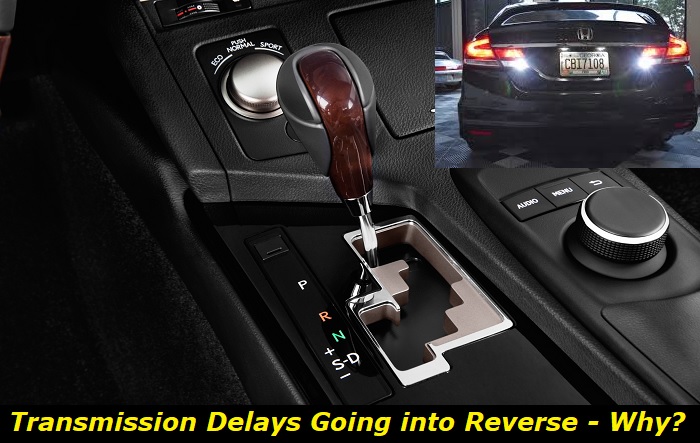A majority of drivers often overlook the reverse gear. Most people assume a vehicle moving forward is all that matters and think little about the reverse gear. On the contrary, the reverse gear is as important as other gear and, to some extent, crucial. This story can best be told by someone who has ever been unable to back out of their driveway because of a failed reverse gear.
Transmission shifting delay problem highlights
- Level of importance:Medium
- Reasons:Low fluid, overheating, torque converter problems
- Needed expertise:High
- Needed tools:Depends on the reason
- Time taken:1-8 hours
- Can you drive? Carefully
- Possible issues: Fatal transmission failure, torque converter damage.

The transmission delay going into reverse gear
When driving, you might notice a delay of a second or several after you shift the gear and when the transmission actually engages that gear. This problem can be experienced in both manual and automatic transmission vehicles. It, however, affects the automatics more.
When this delay in engaging the reverse gear happens, it is time to work on the transmission and correct the problem. In some cases, the delay is accompanied by a jerky or uneven engagement of the reverse gear. Attend to the issues soon, especially if this delay happens frequently. This issue can be caused by a number of reasons, some of which you can resolve without involving a mechanic. Other causes are a symptom of a more serious problem, and that's why you shouldn't delay in resolving this problem.
Things to do when your vehicle has a transmission delay going into reverse gear
Every experienced driver knows that whenever they notice a problem with their vehicle, the first thing to do is to try and know what is wrong. Hearing a loud noise from under the vehicle calls for you to stop and investigate the problem and see whether you can do anything about it. This is the same thing to do when you notice a problem with the reverse gear delay.
Check your service records and determine the last time your transmission was flushed. Your user manual has a recommended service interval which you should check against.
Check the transmission fluid level. The transmission fluid should not be overfilled or underfilled. Only use the recommended transmission fluid for your vehicle.
Never attempt to resolve a transmission delay issue by revving the engine. Revving the engine is likely to make the problem worse.
Prolonged driving of your car when the transmission has a delay when going into reverse gear will lead to more damage to the transmission.
What causes transmission delays into reverse gear?
1) Valves sticking the valve body
The valve body comprises several components, all of which must work smoothly for the valve to do its job effectively. A sticky valve body means some parts aren't working as required, making them stuck during operation.
A sticky valve body is caused by poor cooling. High temperatures cause valve body parts to break down prematurely. The extreme heat and carbon deposits will cause the throttle valves and modulator valves on older cars and governors to become sticky.
The obvious symptom of this problem is a delay in engaging gears because the transmission is struggling between gears. A noticeable delay of a second or two when you engage the reverse gear is a telltale sign. Of course, we are assuming the clutch is in good shape here.
Solution
- Start by removing the transmission pan and draining the fluid to inspect the valve body.
- Clean the screen or replace the filter. Clean the magnets at the bottom of the pan.
- If your vehicle is without an oil pan, remove the drain plug and replace the external filter. You should then refill with the right transmission fluid.
- Reinstall the pan. A new gasket is advisable.
- Fill the transmission with the right fluid up to the recommended level.
- Take a drive to bring the transmission to the operating temperature and check the fluid level. The user manual should help you check the transmission level when the vehicle is in N or P.
2) Faulty transmission solenoids
Newer vehicles use transmission solenoids to control the flow of transmission fluid. The transmission control module (TCM) will send an electrical signal to the solenoid when and at what rate to transfer fluid into and out of the transmission. How the transmission solenoid works will vary in CVT, manual or automatic transmission.
A bad transmission solenoid will have the following symptoms:
- Rough shifting
- Gear stick can get stuck in neutral
- A delay in shifting when accelerating or slowing down. A delay will also be experienced in the reverse gear.
- Transmission won't downshift
- Engine loudly revs
- Check engine light or transmission light
Solution
A faulty transmission solenoid should throw a P0750 error code. The codes can be specific such as P0753 indicating an electrical shift solenoid A fault. Besides the symptoms, your OBD II scanner should help you know the exact problem you are dealing with.
Replacing transmission solenoids can be tricky and expensive. You might be forced to replace or service some transmission components to solve a solenoid issue. But ignoring them can lead to you doing expensive repairs on your transmission. In some cases, replacing the transmission fluid can solve a transmission solenoid issue. You should always use the recommended transmission fluid to help avoid this problem.
3) Faulty computer
As highlighted above, the vehicle computer controls the transmission solenoids (TCM). If the TCM is faulty and activates the solenoids improperly, then you will find the delay in gear shifting happening. A faulty TCM can also lead to other transmission problems.
Solution
A faulty TCM will mostly only require reconfiguration.
4) Gunk in the transmission
The purpose of using transmission fluid is to lubricate and cool the moving parts in the vehicle transmission system. If the transmission breaks down, the oil fluid will not reach all parts, making the transmission very hot hence causing premature wear and tear and other problems.
Before you check the valve body or the transmission solenoids, it is advisable to confirm that it is not gunk causing the reverse gear delays. Accumulating sludge in the reverse gear passage will normally cause the gear to delay and a slam. Sludge in the transmission is usually caused by the following;
- Very short trips that don't allow the engine to reach operating temperature
- Contamination by dirt
- Oxidization of oil
- Condensation of water
- Stop-and-go traffic
- Prolonged idling
- Towing
Solution
- Start by draining the transmission
- Add transmission fluid. Avoid synthetic fluid because the idea is to have a high temperature inside the transmission to help clear the stuck sludge. You can always change back to synthetic later.
- You can use 'stops slip' fluid which helps prevent hard shifting and sticking of the gears. Mix the stop slip fluid with the transmission so that the total quantity of the mixture is what the transmission can hold. Remember, don't overfill your transmission.
- Start the engine and let the engine reach the operating temperature.
- Shift the gear to R and hold it there for five seconds. Shift to N and hold it for five seconds too. Do this for all the gears. This allows the transmission fluid to flow through the gears and lubricate everything.
- Place stoppers behind the rear wheels.
- Set the parking brake firmly and put the car in Reverse. Leave the engine running for 30 minutes. This helps remove the gunk in the reverse gear passage. It also clears gunk from the valve body.
- Engage the reverse gear and observe whether the gear slam and delay are still there. If the problem is not resolved, it is time to consider taking your car to an expert who will check the valve body, the transmission solenoids, and other transmission components.
Can you prevent the transmission delay into Reverse?
The transmission of your car has many moving parts. Transmission fluid lubricates these moving parts, keeping the transmission in optimal working condition. Over time, the transmission fluid collects dirt and loses its magic effectiveness. This calls for you to service the transmission regularly.
The manufacturer of your vehicle has indicated in the user manual the intervals at which you should service the transmission. Regular servicing of the transmission will ensure that the fluid doesn't clog and the valve body parts don't wear out prematurely.
Ensure you use the recommended transmission fluid on your vehicle. Check the transmission fluid at least twice every year. Another thing to do is be keen to pick out any unfamiliar sounds or smells. This way, you will arrest transmission issues early and help avert disastrous damage to the transmission and your wallet.
Conclusion
The transmission delays going into reverse gear is a problem that is not rare. It can be caused by several reasons, some of which are preventable. Resolving this problem requires that you be proactive to prevent its escalation and severe damage to the transmission and other vehicle parts.
About the authors
The CarAraC research team is composed of seasoned auto mechanics and automotive industry professionals, including individuals with advanced degrees and certifications in their field. Our team members boast prestigious credentials, reflecting their extensive knowledge and skills. These qualifications include: IMI: Institute of the Motor Industry, ASE-Certified Master Automobile Technicians; Coventry University, Graduate of MA in Automotive Journalism; Politecnico di Torino, Italy, MS Automotive Engineering; Ss. Cyril and Methodius University in Skopje, Mechanical University in Skopje; TOC Automotive College; DHA Suffa University, Department of Mechanical Engineering






Add comment